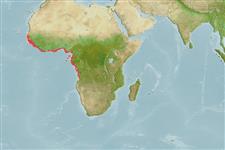Malacostraca |
Decapoda |
Palaemonidae
Environment: milieu / climate zone / Mức độ sâu / distribution range
Sinh thái học
Sống nổi và đáy; Thuộc về nước lợ; Mức độ sâu 3 - 740 m (Tài liệu tham khảo 105050). Tropical; 16°N - 17°S, 18°W - 14°E
Eastern Atlantic: along West African coast, from Senegal to Angola.
Length at first maturity / Bộ gần gũi / Weight / Age
Chín muồi sinh dục: Lm ? range ? - ? cm Max length : 7.5 cm TL con đực/không giới tính; (Tài liệu tham khảo 434)
Pelagic (Ref. 105112). Exploited in the continental shelf (Ref. 121688). Inshore, prefers high salinity river mouths (Ref. 121669). Also found on sandy and muddy bottoms in estuarine and coastal marine waters to depths of about 50 m (Ref. 434). Mainly feeds on mysids and copepods. Preyed upon by fish and decapods (Ref. 105112).
Life cycle and mating behavior
Chín muồi sinh dục | Sự tái sinh sản | Đẻ trứng | Eggs | Sự sinh sản | Larvae
Members of the order Decapoda are mostly gonochoric. Mating behavior: Precopulatory courtship ritual is common (through olfactory and tactile cues); usually indirect sperm transfer.
Fischer, W., G. Bianchi and W.B. Scott (eds.) 1981 Shrimps and prawns. 6: pag.var. In FAO species identification sheets for fishery purposes. Eastern Central Atlantic (Fishing Area 34, 47; in part). Canada Funds-in-Trust. Ottawa, Department of Fisheries and Oceans Canada, by arrangement with the Food and Agriculture organization of the United Nations. 1-7: pag.var. (Tài liệu tham khảo 434)
IUCN Red List Status
(Tài liệu tham khảo 130435: Version 2025-1)
CITES status (Tài liệu tham khảo 108899)
Not Evaluated
CMS (Tài liệu tham khảo 116361)
Not Evaluated
Threat to humans
Human uses
Các nghề cá: Tính thương mại
FAO - Các nghề cá: landings | FishSource |
Các công cụ
Thêm thông tin
Life cycleSự tái sinh sảnChín muồi sinh dụcSự sinh sảnĐẻ trứngEggsEgg developmentLarvae PhysiologyThành phần ô-xy
Human RelatedStamps, coins, misc.
Các nguồn internet
Estimates based on models
Preferred temperature
(Ref.
115969): 11 - 16.4, mean 14.2 (based on 40 cells).
Fishing Vulnerability
Low vulnerability (10 of 100).
